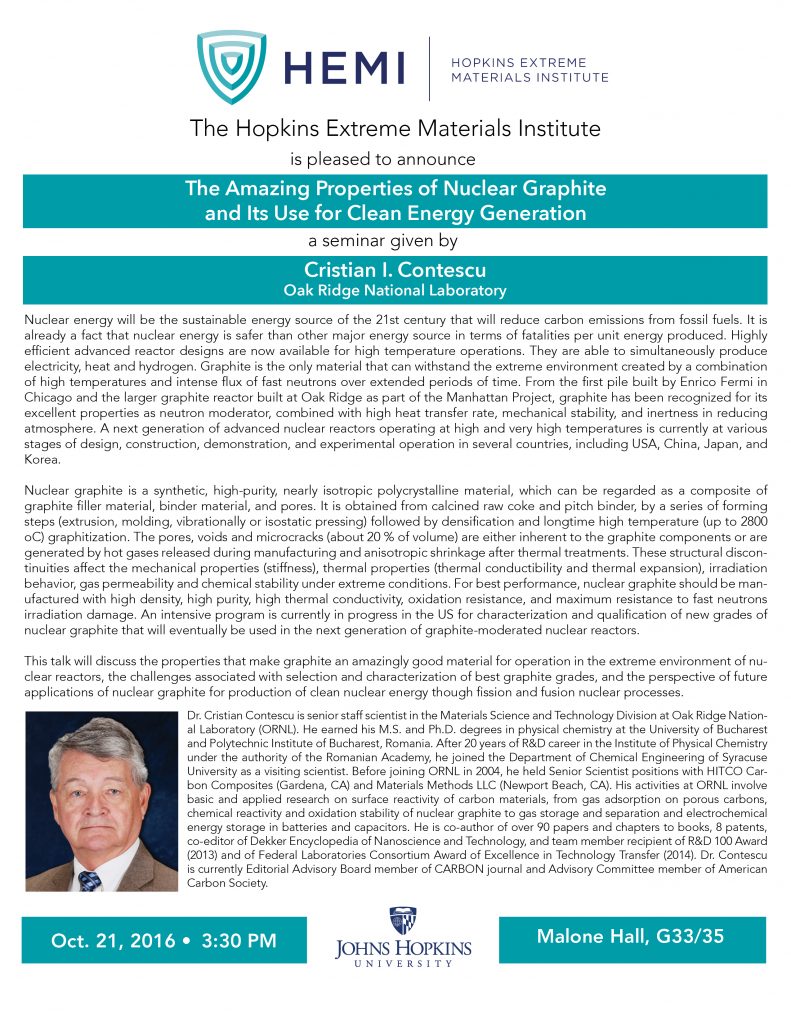October 21, 2016 @ 3:30 pm - 4:30 pm
Event Navigation
The Amazing Properties of Nuclear Graphite and Its Use for Clean Energy Generation
Cristian I. Contescu, Oak Ridge National Laboratory
Nuclear energy will be the sustainable energy source of the 21st century that will reduce carbon emissions from fossil fuels. It is already a fact that nuclear energy is safer than other major energy source in terms of fatalities per unit energy produced. Highly efficient advanced reactor designs are now available for high temperature operations. They are able to simultaneously produce electricity, heat and hydrogen. Graphite is the only material that can withstand the extreme environment created by a combination of high temperatures and intense flux of fast neutrons over extended periods of time. From the first pile built by Enrico Fermi in Chicago and the larger graphite reactor built at Oak Ridge as part of the Manhattan Project, graphite has been recognized for its excellent properties as neutron moderator, combined with high heat transfer rate, mechanical stability, and inertness in reducing atmosphere. A next generation of advanced nuclear reactors operating at high and very high temperatures is currently at various stages of design, construction, demonstration, and experimental operation in several countries, including USA, China, Japan, and Korea.
Nuclear graphite is a synthetic, high-purity, nearly isotropic polycrystalline material, which can be regarded as a composite of graphite filler material, binder material, and pores. It is obtained from calcined raw coke and pitch binder, by a series of forming steps (extrusion, molding, vibrationally or isostatic pressing) followed by densification and longtime high temperature (up to 2800 oC) graphitization. The pores, voids and microcracks (about 20 % of volume) are either inherent to the graphite components or are generated by hot gases released during manufacturing and anisotropic shrinkage after thermal treatments. These structural discontinuities affect the mechanical properties (stiffness), thermal properties (thermal conductibility and thermal expansion), irradiation behavior, gas permeability and chemical stability under extreme conditions. For best performance, nuclear graphite should be manufactured with high density, high purity, high thermal conductivity, oxidation resistance, and maximum resistance to fast neutrons irradiation damage. An intensive program is currently in progress in the US for characterization and qualification of new grades of nuclear graphite that will eventually be used in the next generation of graphite-moderated nuclear reactors.
This talk will discuss the properties that make graphite an amazingly good material for operation in the extreme environment of nuclear reactors, the challenges associated with selection and characterization of best graphite grades, and the perspective of future applications of nuclear graphite for production of clean nuclear energy though fission and fusion nuclear processes.
Seminar will be held at 3:30 PM in Malone Hall, G33/35.





